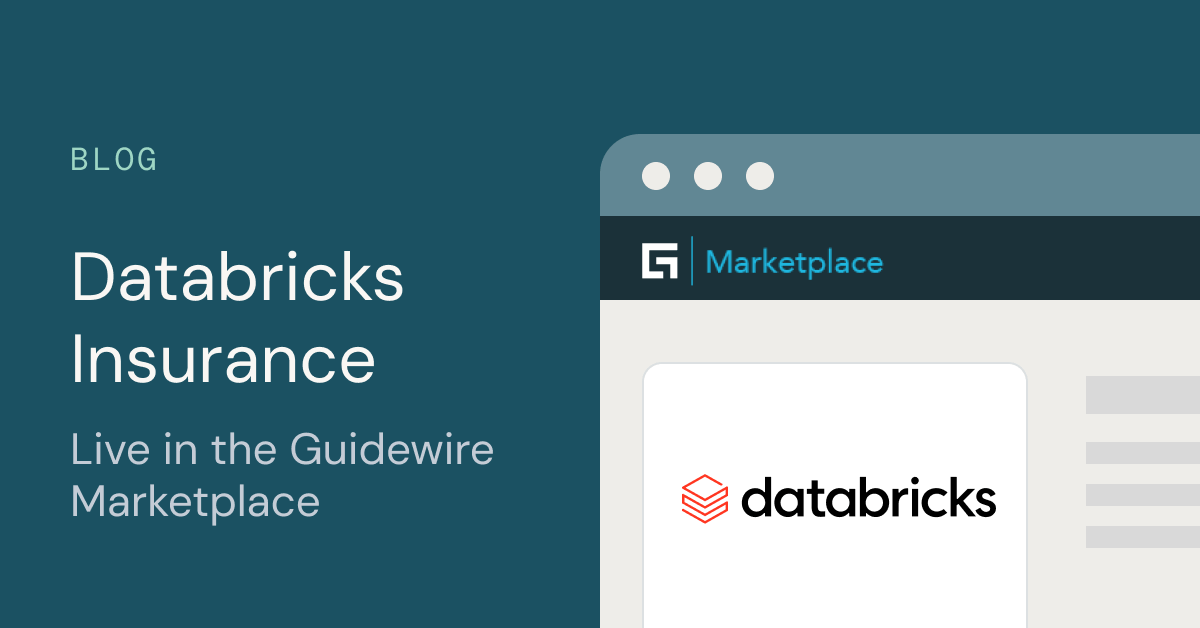Databricks Insurance: Live in the Guidewire Marketplace
Databricks and EY bring together the next level of data insurance

To mark the announcement of Databricks listing in Guidewire Marketplace, Marcela Granados, our GTM Director for Insurance, Justin Fenton, Senior Director, Alliances, sat down to discuss why Databricks' inclusion in the Guidewire Marketplace matters most for Insurance companies.
Justin: Marcela to kick us off, can you update me on the current state of Databricks in the insurance industry? How is the adoption? What are insurance customers' thoughts on Databricks?
Marcela: Absolutely, Justin! I'm thrilled that you've asked me to discuss this. In 2022, we've witnessed a significant evolution in the utilization of Databricks among our insurance customers. Traditionally, Databricks was regarded as an ETL engine, valued for its processing power and computational advantages. However, with the progress we've made in our product, insurance companies are now leveraging Databricks for end-to-end data pipelines.
For instance, the introduction of advanced features like Delta Live Tables has allowed us to reach a broader audience. It's not limited to just expert coders or data engineers and scientists, but also those with semi-technical backgrounds. Delta Live Tables enables insurance companies to create current pipelines with fewer lines of code. The beauty is, it reads like English, making it easier to comprehend. Additionally, it empowers them to set expectations regarding data quality. This aspect has proven exceptionally valuable for insurance companies when they need to track incomplete data and ensure it reaches the serving layer for data visualization.
Justin: So, it appears that Databricks is growing and evolving over time. We've introduced new features, and insurance customers are expanding their utilization of the platform. Could you enlighten us on what our biggest insurance customers are developing or utilizing with Databricks?
Marcela: Of course! Our largest insurance companies have embraced various use cases related to claims. They prioritize applications such as claims severity models, frequency models, fraud detection, waste and abuse identification – essentially anything that assists with streamlining the entire claim adjudication process. Why focus on claims? Well, because there's always an abundance of data available, and it doesn't require direct customer interaction. Even if you're a smaller or midsize carrier, you possess sufficient data to build reliable models. It's the back-office realm where claims have been significantly utilized.
Now, shifting gears to the past one to two years, underwriting and pricing has emerged as use cases that deliver immense value. This is primarily due to the insurance market being seen as commoditized in some areas. Let's consider personal auto insurance as an example, where numerous carriers exist. We're not talking about your typical insurance firms here – there's a surge of digital-native companies offering personalized auto insurance to various demographics.
This industry shift has prompted insurance companies to revamp their architecture and contemplate how to embrace digital transformation, providing customers with a tailored experience. Even if you still cater to the traditional 55-year-old individual who responds to paper mail, you can still satisfy their needs. But companies also want to have this omnichannel experience and know when to engage which channel with their customers, hyper-personalize their product, their offerings, and their coverages. Insurance companies have the need for more data on a real-time basis to customize the experience and ultimately, drive competitive advantage.
Justin: So, if I understood correctly, Databricks is really driving the transformation of companies in the insurance industry when it comes to claims, underwriting, and pricing. But what else can insurance companies expect from Databricks? What's the next step?
Marcela: I'm so excited to share that Databricks is now in the Guidewire Marketplace. This means that the world's largest insurance companies can now easily blend and enhance their Guidewire data on the Databricks Platform. You will now be able to model with more accuracy, make smarter decisions and truly run a robust business without traditional data silos. Customers will be able to advance and innovate in their personalized offers at a greater scale with the introduction of Guidewire data in the Data Intelligent Platform.
Justin: How have we operationalized all of this?
Marcela: We've joined forces with EY to make this vision a reality. Databricks and Guidewire have independently had very strong partnerships with EY and this is bringing it all together. The marketplace solution will solve a big data challenge for customers, bringing Guidewire data into the Data Intelligence Platform. But EY takes it further. EY brings its deep industry expertise to the table and builds additional solutions on top of this newfound data interoperability. They offer a range of services like claims analysis, marketing and underwriter dashboards, quote analytics, and more.
To view Databricks in the Guidewire Marketplace, click here


